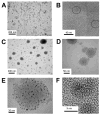Biocompatible luminescent silicon quantum dots for imaging of cancer cells
- PMID: 19206483
- PMCID: PMC2676166
- DOI: 10.1021/nn700319z
Biocompatible luminescent silicon quantum dots for imaging of cancer cells
Abstract
Luminescent silicon quantum dots (Si QDs) have great potential for use in biological imaging and diagnostic applications. To exploit this potential, they must remain luminescent and stably dispersed in water and biological fluids over a wide range of pH and salt concentration. There have been many challenges in creating such stable water-dispersible Si QDs, including instability of photoluminescence due their fast oxidation in aqueous environments and the difficulty of attaching hydrophilic molecules to Si QD surfaces. In this paper, we report the preparation of highly stable aqueous suspensions of Si QDs using phospholipid micelles, in which the optical properties of Si nanocrystals are retained. These luminescent micelle-encapsulated Si QDs were used as luminescent labels for pancreatic cancer cells. This paves the way for silicon quantum dots to be a valuable optical probe in biomedical diagnostics.
Figures





Similar articles
-
Preparation, cytotoxicity and in vivo bioimaging of highly luminescent water-soluble silicon quantum dots.Nanotechnology. 2015 May 29;26(21):215703. doi: 10.1088/0957-4484/26/21/215703. Epub 2015 May 6. Nanotechnology. 2015. PMID: 25943071
-
The effects of drying technique and surface pre-treatment on the cytotoxicity and dissolution rate of luminescent porous silicon quantum dots in model fluids and living cells.Faraday Discuss. 2020 Jun 19;222(0):318-331. doi: 10.1039/c9fd00107g. Faraday Discuss. 2020. PMID: 32104862
-
Laser-synthesized oxide-passivated bright Si quantum dots for bioimaging.Sci Rep. 2016 Apr 22;6:24732. doi: 10.1038/srep24732. Sci Rep. 2016. PMID: 27102695 Free PMC article.
-
Silicon quantum dots for biological applications.Adv Healthc Mater. 2014 Jan;3(1):10-29. doi: 10.1002/adhm.201300157. Epub 2013 Aug 15. Adv Healthc Mater. 2014. PMID: 23949967 Review.
-
Luminescent quantum dots: Synthesis, optical properties, bioimaging and toxicity.Adv Drug Deliv Rev. 2023 Jun;197:114830. doi: 10.1016/j.addr.2023.114830. Epub 2023 Apr 20. Adv Drug Deliv Rev. 2023. PMID: 37086917 Review.
Cited by
-
Low-Cost Synthesis of Silicon Quantum Dots with Near-Unity Internal Quantum Efficiency.J Phys Chem Lett. 2021 Sep 23;12(37):8909-8916. doi: 10.1021/acs.jpclett.1c02187. Epub 2021 Sep 9. J Phys Chem Lett. 2021. PMID: 34498875 Free PMC article.
-
Magnetic luminescent porous silicon microparticles for localized delivery of molecular drug payloads.Small. 2010 Nov 22;6(22):2546-52. doi: 10.1002/smll.201000841. Small. 2010. PMID: 20814923 Free PMC article.
-
Optically stable biocompatible flame-made SiO2-coated Y2O3:Tb3+ nanophosphors for cell imaging.ACS Nano. 2012 May 22;6(5):3888-97. doi: 10.1021/nn205035p. Epub 2012 May 4. ACS Nano. 2012. PMID: 22509739 Free PMC article.
-
Review of Mn-Doped Semiconductor Nanocrystals for Time-Resolved Luminescence Biosensing/Imaging.ACS Appl Nano Mater. 2022 Dec 23;5(12):17413-17435. doi: 10.1021/acsanm.2c04337. Epub 2022 Nov 30. ACS Appl Nano Mater. 2022. PMID: 36874078 Free PMC article.
-
Si nanocrystal solution with stability for one year.RSC Adv. 2018 Dec 11;8(72):41299-41307. doi: 10.1039/c8ra08816k. eCollection 2018 Dec 7. RSC Adv. 2018. PMID: 35559330 Free PMC article.
References
-
- Prasad PN. Nanophotonics. Wiley-Interscience; New York: 2004.
-
- Alivisatos AP. Semiconductor clusters, nanocrystals, and quantum dots. Science. 1996;271:933–937.
-
- Prasad PN. Introduction to Biophotonics. Wiley-Interscience; Hoboken, NJ: 2003.
-
- Gao X, Yang L, Petros JA, Marshall FF, Simons JW, Nie S. In vivo molecular and cellular imaging with quantum dots. Current Opinion in Biotechnology. 2005;16:63–72. - PubMed
-
- Medintz IL, Uyeda HT, Goldman ER, Mattoussi H. Quantum dot bioconjugates for imaging, labelling and sensing. Nat Mater. 2005;4:435–446. - PubMed
Publication types
MeSH terms
Substances
Grants and funding
LinkOut - more resources
Full Text Sources
Other Literature Sources
Medical

